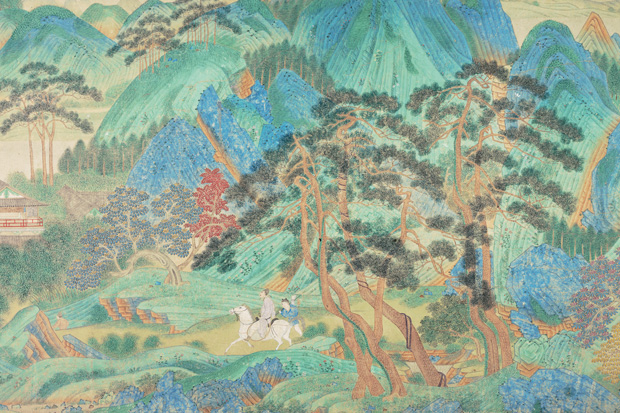My addiction to Chinese landscape painting began in 1965 at the V&A, in a travelling exhibition of the Crawford Collection from America. The catalogue entries were supplied by the doyen of Chinese art historians in Britain, Michael Sullivan, who died aged 97 just a month before the opening of this latest exhibition of Chinese painting at the V&A. His particularly well-written and stimulating books on Chinese art, especially Symbols of Eternity, published in 1980, kept my addiction smouldering until at last I felt I had to do something about it and wrote a novel, The Ten Thousand Things. Its central character is a 14th-century Chinese landscape-painter, Wang Meng, whose ‘total absorption in the language of painting’ reminded Sullivan of Cézanne. Wang’s masterpiece ‘Dwelling in the Blue Bien Mountains’ struck me as an overpowering image, not only of the grandeur and seductiveness of nature, but also of the turbulent times he lived through, the decay and collapse of the alien Mongol regime established by Khublai Khan, years of near anarchy and civil war ending in eventual triumph for the native Chinese under the first Ming Emperor.
Not much noticed except by his friends in his lifetime, Wang became famous 200 years after his death as one of the ‘Four Masters of the Yüan’, four great innovators and leading practitioners of the so-called ‘literati painting’. Their paintings, whether in the form of long horizontal handscrolls or vertical hanging scrolls, were very different in style, but all four worked on paper instead of silk, and tended to avoid colour in favour of calligraphic brush strokes and ink washes. The change had been heralded in the early 12th century by a group of scholars led by the poet Su Shi. Essentially it took painting out of the hands of professional painters — mere artisans — and passed it to highly educated connoisseurs, who were also poets, government administrators and calligraphers, and in doing so changed the purpose of painting from the straightforward representation of nature to the expression of the artist’s mind and feelings. ‘Anyone who talks about painting in terms of likeness,’ wrote Su Shi, ‘deserves to be classed with the children.’
The consequence was that painting became highly referential, much concerned with reflecting the styles and techniques of the masters of the past. The great artist, scholar and connoisseur who fully established this change nearly two centuries after Su Shi was Wang Meng’s grandfather, Zhao Mengfu, though his reputation was always somewhat sullied by his acceptance of high administrative posts under the Mongol invaders. Nevertheless, from then on, even into the 20th century, this idea that unites the calligraphy of poetry and thought with the calligraphy of the seen or imagined landscape — both created by a sophisticated individual with brush and ink — has remained central to the history of Chinese art.
It seemed to me when I was starting my novel that western art had turned in the same direction during the late 19th and early 20th centuries, and perhaps the reason I became addicted to ancient Chinese painting in the 1960s was that it coincided with my equally new addiction to the abstract art of that time, Rothko and Riley, Hoyland, Huxley and Hubbard. Their work, too, depended on the vitality of the technique, the study of past masters and the quality of the artist’s imagination. Of course, these artists worked principally in colour, not black ink, and few if any of them were also scholar-poets, still less government administrators, though some had certainly withdrawn, like the Four Masters of the Yüan, from society into their own minds and studios, if not quite as far as remote mountain hideouts.
This new exhibition of Chinese painting at the V&A, magnificently displayed, includes at least two of the works I saw there nearly 50 years ago, one of them being a deliciously rotund horse and thin groom painted by Zhao Mengfu. The sumptuous catalogue even suggests that the groom is a self-portrait. The show does not, sadly, include any work by Wang himself, though it does contain a famous hanging scroll by his friend Ni Zan, as austere and cool in style as Wang is warm and impassioned. Further on is a hanging scroll by the 17th-century artist Wang Jian — part of a set of 12 ‘Landscapes in the Manner of Old Masters’ — which evokes his great predecessor and namesake Wang Meng, although in a much softened manner, as it were Renoir doing a Rubens. The exhibition’s curator, Zhang Hongxing, told me that he intended the show to enthuse a new generation as the earlier one did me. It surely will, though it perhaps ought to carry a government health warning: Chinese painting is highly addictive.






Comments